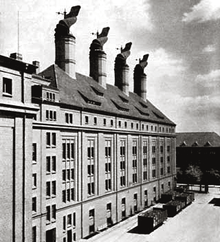Malzfabrik Schöneberg

The Malzfabrik Schöneberg is a former industrial complex in the Berlin district of Tempelhof-Schöneberg . The building ensemble , located at Bessemerstraße 2–14 in the Schöneberg district , was built between 1914 and 1917 and is a listed building . It is a malt house that supplied the brewery company Schultheiss-Patzenhofer Brauerei AG with the necessary ingredients for brewing beer in an industrial manner . With its four large Darrschloten with rotating hoods, the malting plant is a highly visible landmark .
history
The malt factory was built between 1914 and 1917 according to plans by the Dortmund contractor Franz Schlueter, but was not officially opened until 1921 due to the war . The mechanized large-scale production of malt began in 1926. In 1945 the Soviet occupying forces dismantled the larger machines in the malt factory, which had remained almost intact during World War II . In 1950 Schultheiss resumed production, expanded and modernized the facilities until 1960. In 1958/1959 a box malt house was established in which the grain was processed in a more modern way in germination boxes . In addition, a boiler house was built to supply steam to the kilns. In 1962/1963 a malt silo was built on the western side of the site . The brewery group Brau und Brunnen closed the malt factory in 1996 due to the falling demand for bulk beer and the beginning of economic difficulties.
From 2001 to July 2007 there was an interim use by the KitKatClub . Since 2005 the site has belonged to a Swiss investor who, after various uses , wants to establish a creative center there . Since 2009, renovation work has been carried out on the malt factory in cooperation with the architects ioo Elwardt + Lattermann and the German Foundation for Monument Protection , whereby the characteristic kiln hoods have already been dismantled, overhauled and replaced.
Description and construction
The ensemble comprised of several buildings, a Darrentrakt , an antenna building , as well as a high, the roofs superior cubic Silo for the finished malt. In addition, there are buildings for administration, a cellar and a machine house. There is also a horse stable and a warehouse. The malt factory has a siding with a covered turntable , which was served from the former Tempelhof marshalling yard . There is a shed for rail freight cars, which were used to deliver the brewing barley and coal, as well as two round-arched track passages for transporting the finished malt by road vehicles and railroad cars to the breweries. The vehicles were filled by pneumatic pipes installed on the ceiling of the passageways.
Based on the style of Peter Behrens, the six-storey block- shaped Darrentrakt with the four high vapor chimneys made of concrete with attached rotatable Kulmbach kiln hoods on the hipped roof looks representative. With red bricks blind facade is dominated by pilasters , pilasters , a coupled window arrangement and a Zahnschnittgesims divided over the windows. The three-storey tent wing on the north side with a flat monopitch roof, on the other hand, is not as representative as it cannot be seen directly from Bessemerstrasse.
literature
- Werner Hildebrandt, Peter Limburg and Jörg Wewel: Historic buildings of the Berlin industry. Contributions to the preservation of monuments in Berlin, issue 1. Berlin 1988.
- Hans Ehlert: Schultheiss-Patzenhofer, 1871-1921. A look back , Felix Lehmann, Berlin 1921
Web links
- Owner's website
- Information sheet from the Berlin Center for Industrial Culture
- Contribution of the commissioned architecture office on the renovation
Individual evidence
- ↑ Entry in the Berlin State Monument List
- ↑ Website of the current owner
- ↑ Film about kiln renovation
- ↑ Werner Hildebrandt, Peter Limburg and Jörg Wewel: Historic buildings of the Berlin industry. Articles on the preservation of monuments in Berlin, issue 1. Berlin 1988, p. 96 ff.
- ↑ Klaus Rieseler: Early large breweries in Germany The brewery architecture between 1870 and 1930 in the cities of Dortmund, Kulmbach and Berlin , dissertation, TU-Berlin 2003, p. 185 f.
Coordinates: 52 ° 28 '0.4 " N , 13 ° 21' 57.4" E
